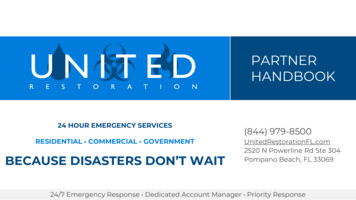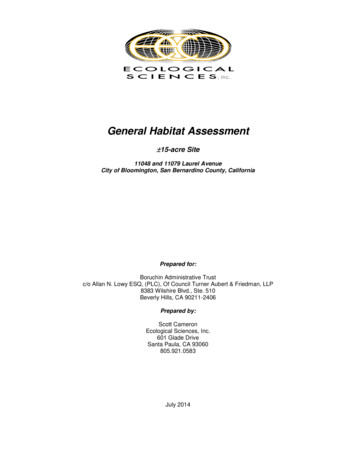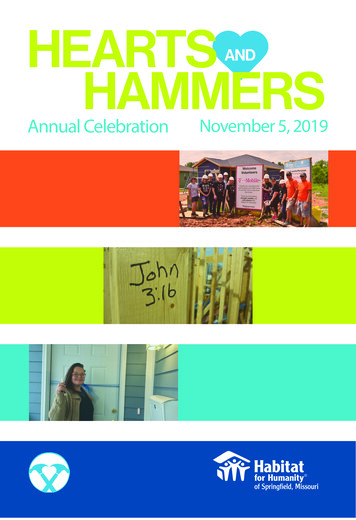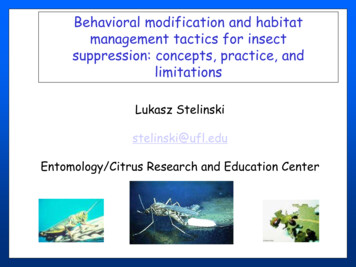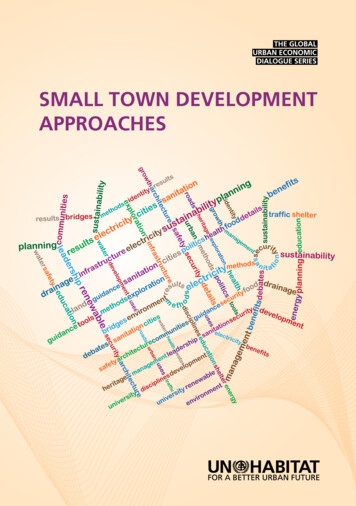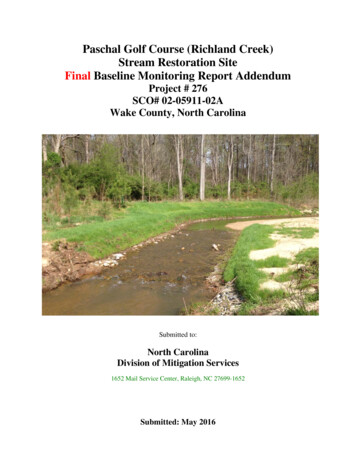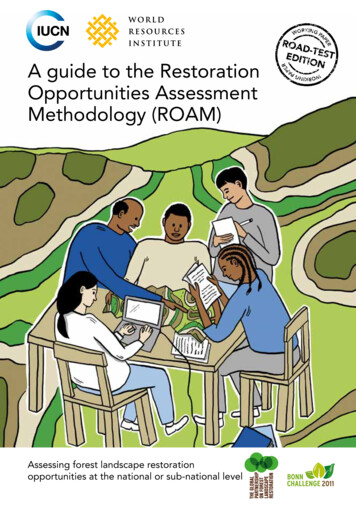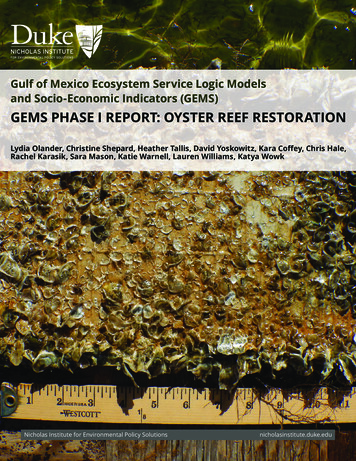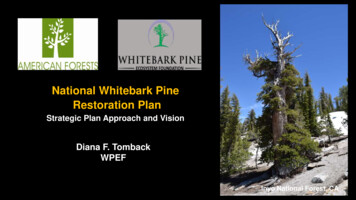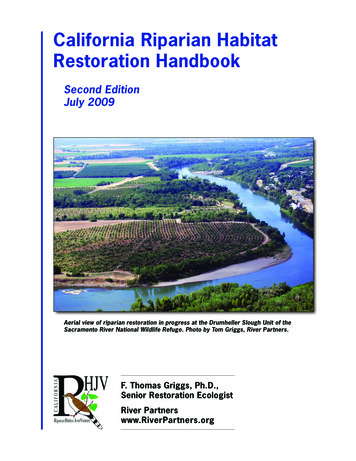
Transcription
California Riparian HabitatRestoration HandbookSecond EditionJuly 2009Aerial view of riparian restoration in progress at the Drumheller Slough Unit of theSacramento River National Wildlife Refuge. Photo by Tom Griggs, River Partners.F. Thomas Griggs, Ph.D.,Senior Restoration EcologistRiver Partnerswww.RiverPartners.org
Riparian Habitat Joint Venture Goal Statement for HandbookCalifornia Partners in Flight (CalPIF) initiated the Riparian Habitat Joint Venture (RHJV) project in 1994.To date, eighteen federal, state and private organizations have signed the landmark Cooperative Agreementto protect and enhance habitats for native landbirds throughout California. The RHJV, modeled after thesuccessful Joint Venture projects of the North American Waterfowl Management Plan, reinforces othercollaborative efforts currently underway which protect biodiversity and enhance natural resources as wellas the human element they support. River Partners is a RHJV partner.The RHJV partners identified a need for guidelines for planning and implementing riparian restorationprojects on the ground. In 2007 the RHJV convened a group of restoration experts for a workshop toproduce a handbook of restoration strategies, standards and guidelines – the birth of this handbook. Thegoal is to provide practitioners, regulators, land managers, planners, and funders with basic strategies andcriteria to consider when planning and implementing riparian conservation projects. The following pageswill cover issues such as: What are the fundamental ecological criteria toconsider for producing quality restoration onthe ground?How can a restoration project be designed tomeet key goals AND provide wildlife habitat?What partnerships, permits, tools and resourcesare required to implement a restorationproject? Which field methods should be used to ensurethe greatest success given a site’s soils andhydrologic setting?What works and doesn’t work in restoration?When and how should the restoration projectbe monitored to continue refining restorationtechniques?The handbook should be used for planning projects, creating budgets, and assessing restoration success.One aim is to provide a common language for riparian restoration, appropriate planning of projects andeffective restoration on the ground. Ecological, biological, and regulatory components of a riparianrestoration project are described. Additional resources of riparian restoration project support are providedincluding web-links and reference articles. Case studies of statewide riparian restoration projects that facedsite specific conditions illustrate implementation of the principles presented in this handbook. This willbe a living document that will be revised to include new information as it becomes available. This secondversion was revised in June 2009 (the first edition was completed in September 2008).This handbook emphasizes the ecological river processes operating on floodplains and in river channelsthat create characteristic vegetation structure that forms wildlife habitat - as the foundation for planninga riparian restoration project. The goal of these guidelines is to explain the proposal/planning process fora site-specific riparian restoration project for wildlife habitat to the first-time as well as the experiencedrestoration project manager.Riparian Habitat Joint Venture Board of DirectorsJohn Carlon, River PartnersCheryl Carrothers, USFS, PacificSouthwest RegionTony Chappelle, WildlifeConservation BoardEric Gillies, California State LandsCommissionContact: Scott Clemons, SClemons@dfg.ca.gov. (916) 445-1072Geoffrey R. Geupel, PRBO ConservationScienceBarbara E. Kus, USGS Western EcologicalResearch CenterCatrina Martin, US Fish and WildlifeServiceMyrnie Mayville, Bureau of ReclamationTom Moore, Natural ResourcesConservation ServiceTom Pagacnik, Bureau of LandManagementMichael Perrone, Department of WaterResourcesChris Potter, California ResourcesAgencyKevin Shaffer, CA Department of Fishand GameErik Vink, The Trust for Public LandCalifornia Riparian Habitat Restoration HandbookJuly 2009 Page
AcknowledgementsFunding for this Handbook was provided by:Resources Legacy Fund FoundationS. D. Bechtel, Jr. FoundationF. Thomas Griggs, Ph.D., Senior Ecologist at River Partners developed the first draftof this Handbook.Meghan Gilbart, Irvine Restoration Fellow at River Partners, researched andcompiled the June 2009 edition of this Handbook.Layout and design by Tempra Board & Associates.The following individuals reviewed an early draft of the handbook in the fall of2007:Kris Vyverberg – California Department of Fish and GameAndrea Jones – National Audubon SocietyVance Russell – National Audubon SocietyMichael Perlmotter – National Audubon SocietyStacy Small – Environmental Defense FundKevin Shaffer – California Department of Fish and GameGeoffrey Geupel – PRBO Conservation ScienceThe following attended a workshop to review the first draft in April 2008:John Anderson – Hedgerow FarmsJohn Carlon – River PartnersAnn Chrisney – RHJV CoordinatorScott Clemons – Wildlife Conservation BoardGreg Golet – The NatureConservancyJames Jones – East Bay MUDBarbara Kus – USGSLaurel Marcus – California LandStewardship InstitutePeter Perrine – WildlifeConservation BoardKent Reeves – Yolo CountyDepartment of Parks and ResourcesJohn Stanley – Founder of Societyfor Ecological RestorationNelia White – California LandStewardship InstituteRestoration on the Drumheller Slough Unit of the SacramentoRiver National Wildlife Refuge. Photo by Tom Griggs.California Riparian Habitat Restoration HandbookJuly 2009Page ii
Table of ContentsRiparian restoration along Bear River in the Feather River watershed. Photo by Tom Griggs, River Partners.I. Introduction1A. AudienceB. Geographical FocusC. How to use this HandbookII. Riparian Restoration Overview2A. The Value of Riparian HabitatB. Riparian DeclineC. Riparian RestorationD. MitigationE. Setting Goals and Planning RestorationIII. Ecology of a River8A. Physical River Processes1.2.3.4.Watershed Area and ElevationWatershed GeologyChannel SlopeRegional Climate and the HydrographB. Plant Response to Physical ProcessesC. Wildlife Response to Vegetation StructureIV. Human Impacts on Riparian Systems15A. Altered River Processes1. Dams2. Levees3. Bank Stabilization4. Water DiversionsB. Altered Geomorphology1. Gravel Mining on Floodplains and In-stream2. Land-leveling for AgricultureCalifornia Riparian Habitat Restoration HandbookJuly 2009Page iii
C. Land Use Conversion1.2.3.4.AgricultureLivestock GrazingLoggingUrbanizationV. Restoration Planning Process19A. Flow-Chart of Planning Process and ExplanationB. Tools for PlanningVI. Design Objectives24A. Objective 1: The Local Community1. Flood Damage Reduction2. Water Quality and Supply3. Recreation and Public Use4. Watershed BenefitsB. Objective 2: The Horticultural Potential1. Soilsa. Texture and Stratificationb. Depth to Water Tablec. Nutrients in Soilsd. Irrigation Methods2. Hydrology, Flood Frequency and Geomorphology3. Plant Material for PropagationC. Objective 3: Designing the Plant Association1. Conceptual Model of Riparian Plant Succession2. Climate Change and RestorationD. Objective 4: Habitat Structure for Wildlife1. Planting Design for Wildlife Structure2. Improving Mitigation Design3. Non-native Invasive PlantsVII. Monitoring Riparian Restoration Projects31A. Implementation MonitoringB. Measuring “Restoration Success”1.2.3.4.The Contract LevelHorticultural SuccessWildlife Use as Restoration SuccessMitigation SuccessC. Post-project, Long-term EvaluationsCalifornia Riparian Habitat Restoration HandbookGriggsPage iv
VIII. Permits36A. Pre-project Approval Permits1. California Environmental Quality Act (CEQA) or National Environmental Policy Act (NEPA)2. Encroachment Permit3. Lake and Streambed Alteration Agreement (1600)4. U.S. Army Corps of Engineers (404)5. Water Quality Certification (401)6. Archeological Survey7. County Land Use Conversion Ordinances8. Voluntary Neighbor Agreements9. Endangered Species ConsultationB. Implementation permits1. Burn permits2. Well-drilling permits3. Herbicide permitsIX. Coordination of Permits, Regulations, and ActivitiesA.B.C.D.E.F.G.H.39Central Valley Flood Protection Board Encroachment PermitsTitle 23 WatersDWR Flood Management DivisionArmy Corps O&M GuidelinesLevee and Reclamation Districts’ ResponsibilitiesRegional and County OrganizationsEndangered Species Act ConsiderationsAdjacent and Neighboring Landuse1. Agriculture2. UrbanizationI. Different Definitions of Restoration in Labor Laws1.2.3.4.5.6.Worker’s CompensationPrevailing WageAgricultural Labor LawU.S. Department of AgricultureCalifornia Department of Pesticide RegulationWildlife Conservation Board, U.S. Fish Wildlife Service, and California Departmentof Fish and Game7. County AgenciesX. How to Build a Budget43XI. Technical Methods of Project Implementation44List of Reasons Why Restoration Projects FailXII. Link to Glossary and References Cited51XIII. Appendices56Appendix 1. California Bioregional Restoration ConsiderationsAppendix 2. Restoration Case StudiesAppendix 3. Ecological and Landscape Considerations of Riparian PlantsCalifornia Riparian Habitat Restoration HandbookJuly 2009Page
I. IntroductionA. AudienceThe intended audience for this California Riparian Restoration Handbook is anyone responsible for writinga proposal for a riparian restoration project, anyone beginning to plan and implement the project, or thoseresponsible for compliance and mitigation monitoring of such a project. This handbook explains the elementsof a site-specific riparian restoration project that must be addressed in order for a project to be successful.B. Geographic FocusRiver processes operate on all sizes of rivers from the major rivers of the world down to small rivuletsflowing through a mountain meadow. The area over which they operate and the timing of their effectsvary throughout the bioregions of the state. Restoration objectives and restoration practices are likely to bedifferent on rivers and floodplains depending upon their topographic and climatic settings. The material inthis handbook was developed primarily from experience with rivers in California’s Central Valley, and istherefore most applicable to habitat restoration in the Central Valley and on the floodplains of coastal rivers.Many of the concepts are applicable to other bioregions of the state, though the timing and magnitudesof restoration tasks would likely be very different. An overview of the major restoration objectives asthey apply to other bioregions throughout California is provided in Appendix 1. Case studies of riparianrestoration projects outside of the Central Valley can be found in Appendix 2.C. How to Use This HandbookWhile this handbook is designed to assist with projects from start to finish and to anticipate potentialchallenges, it should not be used as a recipe book or without other resources. The user should have access tolocal expertise concerning riverecology, fluvial geomorphology,The following handbooks contain additional information andplanthorticulture,floodresources for riparian restoration, and there are several otherconveyance and local wildlife.manuals that address riparian restoration methods that should beresearched for specific regions of the state.This handbook demonstrates howto approach riparian restoration CDFG (California Department of Fish and Game),design from an ecological1998. California Salmonid Stream Habitat Restorationperspective specific to theManual (section VI).project location. This handbook NRCS (Natural Resources Conservation Service),describes the existing ecological2007. Stream Restoration Design National Engineeringconditions and physical processesHandbook, Part 654.at the watershed level that must be FISRWG (the Federal Interagency Stream Restorationconsidered when developing anWorking Group), 1998. Stream Corridor Restoration:accurate, site-specific restorationPrinciples, Processes, and Practices.plan that will successfully meet CalPIF (California Partners in Flight), 2008. Bringing thetargeted objectives, with priorityBirds Back: A Guide to Habitat Enhancment for Birdsgiven to wildlife habitat.in the Sacramento Valley.California Riparian Habitat Restoration HandbookJuly 2009Page
II. Riparian Restoration OverviewA. The Value of Riparian HabitatIn the Riparian Bird Conservation Plan (RHJV 2004), riparian refers to areas that are “transitional betweenterrestrial and aquatic ecosystems, providing linkages between water bodies and adjacent uplands andinclude portions of terrestrial ecosystems that significantly influence exchanges of energy and matter withaquatic ecosystems” and the National Research Council devotes an entire chapter to defining this term(NRC 2002; RHJV 2004). For this Handbook, the definition of “riparian” will refer to land area thatencompasses the river channel and its current or potential floodplain.The riparian zone is characterized by a unique set of physical ecological factors in comparison to thesurrounding regional landscape (Gregory et al. 1991). These factors include flooding by the river, richand productive soils, a water table that is within reach of plant roots, and species of plants and wildlifethat are adapted to the timing of fluvial events such as flooding, drought, sediment transport and channelmovement. This dynamic habitat creates a wide variety of growing conditions for riparian plants, and overtime they develop into various structural forms (forests, woodlands, shrublands, meadows and grasslands)across the floodplain. The heterogeneity of riparian forests creates numerous habitat features that explainwhy riparian forests in California support a greater diversity of wildlife than any other habitat type (Smith1980). Riparian vegetation along river channels also functions as primary regional migration routes formost wildlife.Riparian ecosystems support people as well as wildlife. Rivers and their floodplains provide many “riverservices” to the surrounding local community. (Also termed “Multiple benefits” by floodway managers.)These include: Conveyance and delivery of water supplyEffective conveyance of flood waters – Native riparian plants on the floodplain attenuate floodwaters and trap large debris.Maintenance of water quality – A living river will improve water quality through biologicalprocessing of pollutants and physical filtering of sediments and organic material.Wildlife habitat and regional migration corridor – Vegetated floodplains provide cover for wildlifeduring migration.Recreation Opportunities – Fishing, hunting, boating, and wildlife viewing are enhanced by nativeriparian plants.River services are optimized when a river and its floodplain are healthy. Healthy rivers are free of intensiveregulation such as dams and revetment and their floodplains support a mosaic of plant communities.California Riparian Habitat Restoration HandbookJuly 2009Page
B. Riparian DeclineThe rich soils and presence of water that make riparian areas biologically rich, also create productive landsfor agriculture and desirable locations for urban development. In addition, sediment deposition by riversover time has provided opportunities for gravel mining. The water that flows through rivers is often dammedand diverted for anthropogenic use and most of the large rivers function as primary flood conveyancestructure for the purpose of human safety. These practices have removed the majority of riparian habitatavailable to wildlife and people and reduced the ability of rivers and floodplains to provide river services.It is estimated that 95 percent of pre-European acres of riparian habitat in California’s Central Valley havebeen lost to recent human activities (Katibah 1984).Transition of some of these lands back to a more natural state through riparian restoration benefits boththe ecology and socioeconomics of a region. Often, rivers are seen only as a means to transport water tocities and farms, or as an unpredictable system that needs to be straightened and armored to prevent flooddamage to developed areas. Healthy rivers and floodplains can protect developed areas from flood damageand provide water transport and other services to people that exceed the cost of replicating these servicesthrough human infrastructure (APEC 2005).Native plants are a necessary component of healthy riparian areas, and not simply because of their importanceto native wildlife. Vegetated floodplains and the organisms they support can clean water by removing thenutrients that runoff from agricultural fields and into drinking water supplies. The presence of vegetationalso aerates the soil and creates places for water to slowly percolate underground to recharge aquifers thatsupply water for urban and agricultural uses. The dense forests also offer shady respite and recreationalopportunities not available in developed areas.C. Riparian RestorationRiparian restoration occurs at a broad range of scales depending on the size of the river, the ecologicalhealth of the site, and the regional landscape. The goals for a restoration project will also vary, from floodcontrol benefits to invasive species removal, but the project can still be designed to maximize habitatavailable to wildlife. (See Appendix 2 for case studies as examples). For example, large rivers in the CentralValley are managed today for irrigation water conveyance and flood-damage control. All are constrained bylevees, with management and maintenance responsibilities carried out by local, state, and federal agencies.Consequently, river processes operate only within the floodway (a legally defined structure, often a leveelined channel that is designed to convey a specific maximum flow during flood events). The floodway’sprimary design consideration is human safety and currently, relatively little emphasis is given to riparianvegetation and habitat function. However, riparian vegetation can have beneficial flood damage controlimpacts by slowing bank erosion, directing flows away from structures, and directing sediment transport.Furthermore, the local influence of restored riparian vegetation can provide both flood control benefits andquality wildlife habitat.Smaller rivers, such as Sierra foothills and Coast Ranges, are tributaries to the larger rivers of California’sCentral Valley and have much smaller localized floodplains covering much smaller areas than those oflarge, meandering valley rivers. On these tributaries, levees are typically protecting small areas (ratherthan regional protection). The emphasis of human safety is usually not as strong on smaller rivers andin this way restoration design is influenced by river size. Restoration on small rivers typically involvesmanipulation/restoration of channel morphology and floodplain elevation (e.g., repairing abandoned open-California Riparian Habitat Restoration HandbookJuly 2009Page
pit gravel mines). In these cases, earth-movement may be a large part of the implementation budget (NRCS2007), with less emphasis on the actual plantings. However, through restoration of river processes such asflooding and sediment transport, eventually native vegetation will establish and support local wildlife.Types of restoration. The amount of human input required by riparian restoration will depend on the siteconditions. “Horticultural restoration” refers to a high level of site management and external human inputsthat include site preparation (land-leveling, disking), planting of nursery-grown trees and shrubs in predesigned patterns, irrigation, and chemical weed-control for three or more years. Horticultural restorationis appropriate along rivers where the river’s physical processes have been severely modified by humanswith dams, levees, bank stabilization, and water diversions. At the other extreme is “process restoration,”which strives to reestablish river processes onto the s
projects on the ground. In 2007 the RHJV convened a group of restoration experts for a workshop to produce a handbook of restoration strategies, standards and guidelines – the birth of this handbook. The goal is to provide
